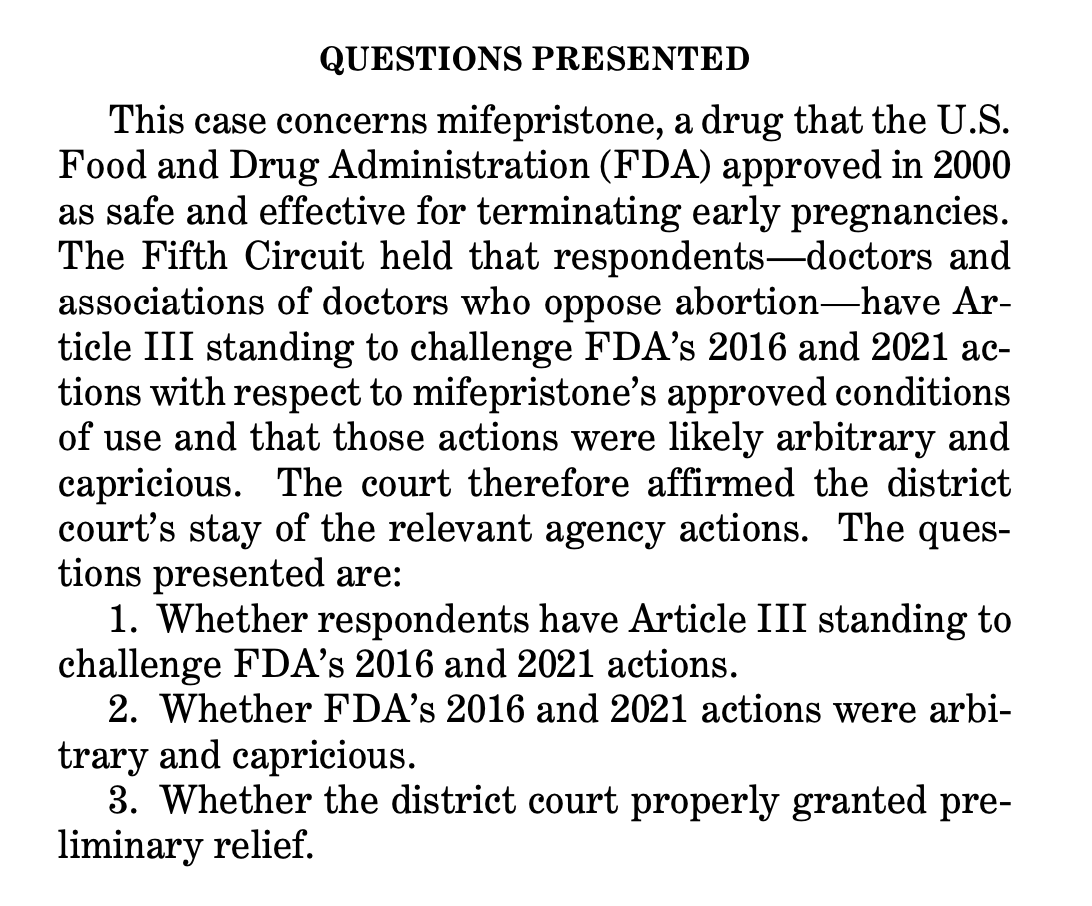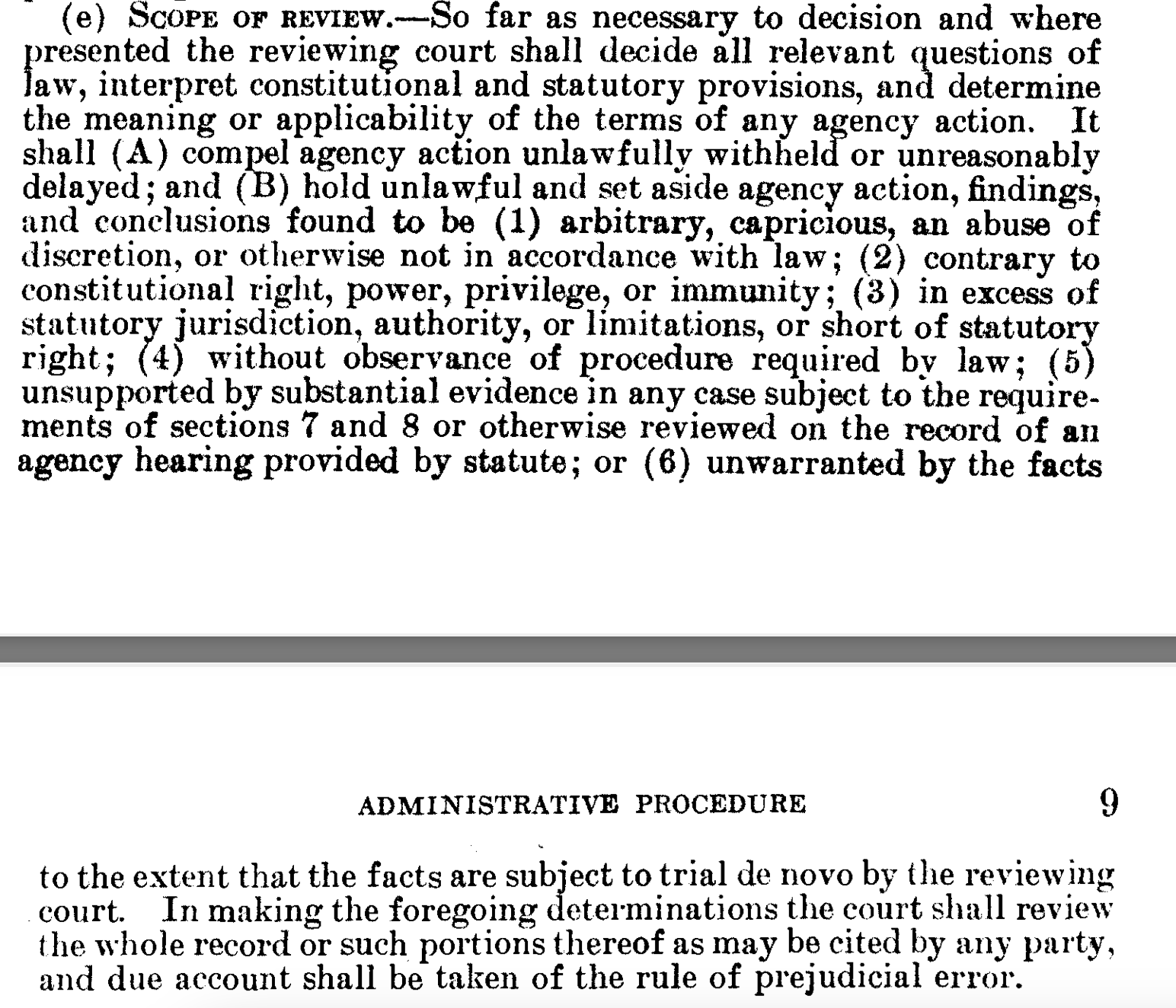Abortion returns to the Supreme Court

Good morning! It’s Tuesday, March 26, 2024. Election Day is 224 days away. If this newsletter was forwarded to you, subscribe here. If you want to contribute to support my work, donate here.
After the Supreme Court overturned Roe v. Wade in 2022, it was widely assumed that the decision would lead to a sharp decrease in the number of abortions performed in the United States.
One team of researchers projected that legal abortions would drop by around 14%; another academic’s “conservative estimate” was that 25% of those who previously would have obtained abortions would instead give birth. The numbers varied, but, directionally, there was no dispute — on either side of the aisle. Sen. Ted Cruz (R-TX) asserted that the Dobbs decision would “save the lives of millions of innocent babies.”
It was an obvious prediction. The Supreme Court had just eliminated the constitutional right to an abortion, paving the way for about half of U.S. states to ban or restrict the procedure; how could the number of abortions do anything but hurtle down?
But that near-unanimous assumption proved incorrect. A recent study by the Guttmacher Institute (a pro-choice group which contributed to the pre-Dobbs research predicting a 14% drop) found that abortions have, in fact, increased in the U.S. since the end of Roe.
In 2023, the institute concluded, just over 1 million abortions were performed across the country, more than in any year in the last decade. (This number includes only abortions performed within the formal medical system, so it is not reflective of an increase in “back-alley” abortions after Dobbs. Other studies have found that abortions outside the medical system also increased after the decision.)
This counterintuitive outcome has many causes, including the fact that many blue states expanded access to abortion at the same time that red states curtailed it. (Unsurprisingly, abortions rose particularly in places that bordered states with abortion bans.) Another major factor: the increased availability of medication abortion, the two-pill regimen that can end a pregnancy without surgery.
In 2023, according to the Guttmacher study, more than 600,000 medication abortions were performed in the U.S. — 63% of the total abortions done within the formal medical system, up from 53% in 2020.
This data helps explain the stakes of FDA v. Alliance for Hippocratic Medicine, the Supreme Court’s first abortion case since Dobbs, which the justices will hear today. The case concerns the availability of medication abortion — charting the future of what has now become the dominant method of abortion in the U.S.
Let’s look at the background of the case, and then return to considering the stakes.
The case stems from a lawsuit by the Alliance for Hippocratic Medicine (AHM), a consortium of doctors and medical groups, challenging the Food and Drug Administration’s (FDA) actions concerning mifepristone, the pill that is used — along with misoprostol — to perform medication abortions.
Mifepristone was first approved by the FDA in 2000, but only for the first seven weeks of pregnancy and if given to patients over the course of three in-person visits to a doctor. Those limitations would later by amended twice. In 2016, the FDA approved mifepristone use for the first 10 weeks of pregnancy, mandated only one in-person visit to a clinic or hospital, and allowed providers besides doctors to prescribe it (such as physician assistants and nurse practitioners). In 2021, during Covid, the agency dropped the in-person requirement entirely, allowing patients to be prescribed mifepristone virtually and then to receive the pill by mail.
Last year, federal district judge Matthew Kacmsaryk sided with AHM, invalidating the FDA’s 2000 approval of mifepristone and the 2016 and 2021 updates — a ruling which would have ended all access to the abortion pill. (Kacmsaryk’s order, and the subsequent circuit court ruling, have been paused until the Supreme Court decides the case.) The Fifth Circuit Court of Appeals then partially reversed Kacmsaryk’s order, ruling that it was too late to strike down the 2000 approval but agreeing with him that the 2016 and 2021 changes were unlawful.
Both sides appealed the parts of the Fifth Circuit ruling they disagreed with. The FDA asked the Supreme Court to reverse the portion that struck down the 2016 and 2021 mifepristone expansions; AHM asked the justices to reverse the preservation of the original 2000 approval.
Which of these requests did the Supreme Court be grant?
Only the first one, from the FDA.
Here are the three questions the court will be considering today:

Note that the court had the opportunity to tackle a competing set of questions relating to the 2000 approval, but the justices denied AHM’s appeal. (It takes four justices to vote to accept a case.)
That means that the consequences of today’s case are substantial, considering the recent uptick in mifepristone distribution through virtual prescriptions and mail-order, but not nearly as substantial as they could have been. The case could not lead to a complete revocation of mifepristone access, only to a change in how recipients access it.
According to a study by the Society of Family Planning of abortions between July and September 2023, about one in six abortions during that period were conducted via telehealth, the type the Supreme Court could roll back.
Now that we’ve established the broader stakes, let’s circle back to the three specific questions the court will be considering:
1) Can AHM challenge the FDA in the first place? Under federal standing doctrine, individuals or groups can only challenge a government action if they can prove they’ve suffered (or will suffer) a specific injury stemming from the action. In this case, the FDA argues that AHM does not have standing, because there is no requirement that their doctors prescribe mifepristone to anyone; in other words, the agency argues, the FDA’s actions don’t affect the doctors because it doesn’t compel them to do anything.
However, the AHM doctors argue that they are injured by the “substantial risk” that they might have to treat someone who has suffered complications from mifepristone, even if they weren’t the ones who prescribed the pill. The FDA calls this a “speculative chain of possibilities,” but the Fifth Circuit ruled that the pill leads to enough “adverse effects” that the emergency room doctors in AHM’s membership are indeed, “likely to be injured by FDA’s actions.” If the Supreme Court finds that AHM lacks standing, it would allow the justices to avoid resolving the thornier questions about mifepristone — an escape hatch they sometime use in controversial cases.
2) Were the 2016 and 2021 expansions to mifepristone access “arbitrary and capricious”? This is the hot-button question in the case. The phrase “arbitrary and capricious” here comes from the Administrative Procedure Act (APA) of 1946, which is the foundational law establishing how federal agencies should issue regulations and how federal courts should review them. (Until the law, courts had almost no recourse to strike down regulations.)
Here’s the APA provision that introduces the “arbitrary and capricious” test:

This test — which requires regulations to be “reasonable and reasonably explained,” according to Supreme Court precedent — has gotten in the way of many an agency action in the past, including the Obama administration’s Deferred Action for Childhood Arrivals (DACA) program (as well as the Trump administration’s efforts to unwind it).
Here, AHM is accusing the FDA of conducting a flawed process when deciding whether to expand mifepristone access in 2016 and 2021, charging that the agency did not consider enough data on the adverse effects of the pill. The FDA denies these charges, saying they conducted an “exhaustive review” of the scientific record. The Fifth Circuit sided with AHM, finding that the agency “failed to address the cumulative effect” of its changes.
3) Were the lower courts right to strike down the 2016 and 2021 changes? Finally, the Supreme Court will consider whether — even if the FDA’s changes were, in fact, based on a flawed process — the lower courts were correct in finding the proper remedy to be rolling back those changes entirely.
The FDA argues that the Fifth Circuit should have given the agency the opportunity to address its concerns about the process before suspending the changes and altering a “years-long status quo” that would, according to the FDA, “inflict profound harm on women, the medical system, the agency, and the public.” AHM, meanwhile, said that “the public — including women using mifepristone — will benefit from FDA restoring key safeguards that once protected women’s health,” arguing that the proper remedy is to overturn the expansions to access immediately.
As is often the case at the Supreme Court, the questions are narrow and legalistic — more concerned with process and technicalities than anything — but the justices’ answers to them could limit access to America’s most common abortion method, a method which has only grown in frequency since the court’s last abortion ruling. (And those limits could impact some of the exact ways in which the method has become more common post-Dobbs, as some organizations have zeroed in on mail distribution of mifepristone as a way to get around abortion bans.)
The justices will likely issue their decision in June, coming — like Dobbs — mere months before an election in which abortion is poised to be a leading issue. It will not be the only abortion decision coming this summer: the justices are also set to hear arguments next month concerning Idaho’s near-total ban on abortions in medical emergencies.
Finally, beyond the political and abortion-related consequences, this case could reverberate because of what it means not just for the FDA’s decisions on mifepristone — but potentially other drug decisions as well. “To the government’s knowledge, this case marks the first time any court has restricted access to an FDA-approved drug by second-guessing FDA’s expert judgment about the conditions required to assure that drug’s safe use,” the Justice Department wrote in one its briefs to the Supreme Court.
The Fifth Circuit pushed back on that claim, noting other rulings that have reined in the FDA. “The scientists at the FDA deserve our respect and our gratitude, but not our blind deference,” the judges ruled. “That would defy Congress’s clear directive that courts conduct independent legal review of FDA action under the APA.”
Still, such review has rarely played out in such a prominent way, leading the FDA to worry that if the justices find their process in expanding mifepristone access was wanting, it could lead litigants to challenge a host of their decisions — potentially setting up thorny cases over vaccines, birth control pills, and more.
“This is a dagger at the heart of the entire industry,” pharmaceutical executive Jeremy Levin told STAT News. “I would venture to guess that if [the Fifth Circuit ruling stands], the industry will be thrown into complete disarray.”
Oral arguments in FDA v. Alliance for Hippocratic Medicine will begin at 10 a.m. Eastern Time. You can listen here.
Three lawyers will argue before the justices — all of them women, a rarity at the Supreme Court. Solicitor General Elizabeth Prelogar will argue on behalf of the government. Jessica Ellsworth will argue on behalf of Danco Laboratories, the maker of mifepristone. Erin Hawley, a prominent conservative litigator and the wife of Sen. Josh Hawley (R-MO), will argue on behalf of AHM.
Two more things to know.

1) Tensions between the U.S and Israel have reached their highest point since the war in Gaza began. The U.S. on Monday allowed a UN Security Council resolution to pass that called for a ceasefire in Gaza during the month of Ramadan, as well as the immediate and unconditional release of the Israeli hostages held by Hamas. After vetoing previous ceasefire resolutions, the U.S. abstained in the Monday vote.
The U.S. abstention led Israeli Prime Minister Benjamin Netanyahu to cancel a planned delegation set to visit Washington. The trip was supposed to bring two of his closest advisers to D.C. for consultations with the Biden administration over a possible Israeli ground invasion of Rafah, a Gazan city where more than 1 million Palestinian civilians are sheltering. President Biden had personally requested the delegation, adding to the symbolism of the cancellation.
The diplomatic fracas follows days of back-and-forth between the two countries, including Biden’s praise of Senate Majority Leader Chuck Schumer’s call for Netanyahu to be effectively ousted and Vice President Kamala Harris’ warning that Israel could face “consequences” from the U.S. if it moves forward with a Rafah invasion.
- Long read: From ‘I Love You’ to ‘Asshole’: How Joe Gave Up on Bibi (Politico)
2) The first presidential trial in U.S. history is set to begin next month. Judge Juan Merchan ruled Monday that former President Donald Trump’s New York criminal trial — in which he faces charges for falsifying business records tied to hush money payments made to porn star Stormy Daniels — will start on April 15.
The ruling marked a loss for Trump’s legal team, who had asked the judge to delay the case or dismiss it entirely. However, Trump also secured a legal win Monday in his New York civil fraud case, in which an appeals court lowered his required bond payment from $454 million to $175 million. Trump now has 10 days to pay the new amount.
At the same time as Trump scrambles to post the bond, he has come into a windfall: his social media company, Trump Media & Technology Group, officially went public Monday (NASDAQ ticker: “DJT”). Per Bloomberg, the move means Trump’s net worth will increase by more than $4 billion, placing him on the outlet’s list of the world’s 500 wealthiest people for the first time. The new wealth is not liquid, however, as the ex-president is prohibited from cashing in on his Trump Media shares for another six months.
- Related: Billionaires sought to help fund Trump bond in civil fraud case, sources say (Reuters)
More key headlines:
- As Biden tours the country and visits swing states, Trump is fundraising and playing golf (AP)
- Joe Biden’s Political Origin Story Is Almost Certainly Bogus. It May Land Him In Legal Trouble. (Washington Free Beacon)
- Feds recently sought information about Jim Biden’s business dealings in 2 cases (Politico)
- Biden, Promising Corporate Tax Increases, Has Cut Taxes Overall (NYT)
- Congress approved $300M for Ukraine last week. The Pentagon spent it 4 months ago. (Politico)
- Harris steps up her role as ambassador to voters shaky on Biden (WaPo)
- Trump calls on Republicans to challenge DeSantis’ lone Florida supporter in Congress (Politico)
- GOP candidate wants to ax Homeland Security agency (Axios)
- Florida Gov. Ron DeSantis signs bill that bans children under 14 from having social media accounts (NBC)
The day ahead.

White House: President Biden and Vice President Harris will travel to Raleigh, North Carolina, where they will deliver remarks at an official event and participate in a campaign fundraiser.
Congress: The House and Senate are on recess.
Supreme Court: The justices will hear oral arguments in the mifepristone case. Listen at 10 a.m. ET
Campaign Trail: Independent presidential contender Robert F. Kennedy, Jr. will announce his vice presidential candidate at a rally in Oakland, California. Watch at 2 p.m. ET
- Related: Robert F. Kennedy Jr. flirts with the Libertarian nomination (Politico)
Thanks for reading.
I get up each morning to write Wake Up To Politics because I’m committed to offering an independent and reliable news source that helps you navigate our political system and understand what’s going on in government.
The newsletter is completely free and ad-free — but if you appreciate the work that goes into it, here’s how you can help:
- Donate to support my work or set up a recurring donation (akin to a regular subscription to another news outlet).
- Buy some WUTP merchandise to show off your support (and score a cool mug or hoodie in the process!)
- Tell your family, friends, and colleagues to sign up at wakeuptopolitics.com. Every forward helps!
If you have any questions or feedback, feel free to email me: my inbox is always open.
Thanks so much for waking up to politics! Have a great day.
— Gabe
